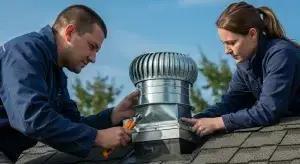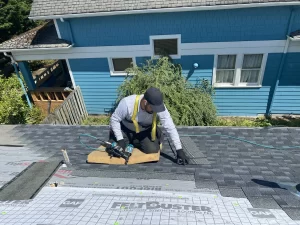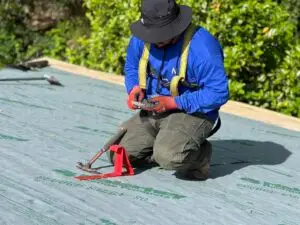Roof sheathing, or roof decking, is a structural layer of boards (plywood or OSB) fixed to roof joists/trusses. It supports roofing materials, resists weather, and adds stability. Roof sheathing provides a foundation for the shingles, tiles, or other roofing materials.
Even though the terms are used interchangeably, sometimes “decking” broadly refers to the entire load-bearing surface under the roof covering, while “sheathing” specifically refers to the wood panels or boards used in that layer. Although often overlooked in roofing discussions, sheathing plays an important role in your roof’s durability, and improper sheathing can lead to leaks, sags, and structural damage.
Historically, when cedar shakes were the primary roofing material, sheathing was made of wooden boards with gaps that allowed ventilation and space for the wood to expand. However, modern roofing construction uses continuous sheathing without any gaps so that there’s maximum support for today’s roofing materials.
In this blog, we’ll explore the importance of roof sheathing, the tell-tale signs of sheathing issues, cost considerations, and more.
The Importance of Roof Sheathing
The sheathing is like your roof’s backbone and performs multiple functions. Here are a few essential functions of sheathing on your month.
Provides Structural Support
It helps distribute the weight of roofing materials (and snow) evenly across the roof. This prevents sagging and uneven surfaces, which could affect the roof’s performance. The sheathing also helps to bridge gaps between different structural elements by providing a continuous layer of support.
Offers a Nailable Surface
Roofing materials such as metal panels and shingles need a solid surface for attachment, and sheathing provides that.
When the sheathing is not installed properly, or there are gaps in the sheathing such that shingles are nailed into each other without any continuous nailing surface underneath, the roof can fail.
Different roofing materials have different sheathing requirements. For example, older homes with gaps in the sheathing (originally designed for wooden shakes that expand), need the gaps to be filled ,or a new continuous layer of sheathing needs to be installed over the existing one.
Protects from Moisture and Weather
Even though sheathing is not the primary barrier against weather – that function is served by the shingles and underlayment – sheathing still offers some protection.
Well-installed sheathing prevents leaks and regulates moisture levels in the attic, which could otherwise lead to mold and rot. In places with harsh weather like Seattle, the sheathing also helps the roof withstand high winds.
Offers Fire Resistance
Some types of sheathing, such as FRT plywood and gypsum board, offer fire resistance by slowing down the spread of flames. This is especially important in areas more prone to wildfires.
Types of Roof Sheathing
Sheathing comes in various materials, and the one that will work best for you depends on the climate conditions, functionality, cost, durability, and local building codes. Below are some of the most common types of roof sheathings:
| Type of Sheathing | Description | Pros | Cons |
| Plywood | A durable wood panel is made by gluing thin layers of wood veneer together. | Resists moisture; strong, long lifespan | More expensive than OSB |
| Oriented Strand Board (OSB) | Made from compressed wood strands and adhesives. The most common sheathing material today. | Cost-effective, widely available | Less water-resistant than plywood |
| Tongue-and-Groove Boards | Traditional solid wood planks with interlocking edges. Common in older homes. | Strong and visually appealing | More expensive, harder to install |
| Fire-Rated Sheathing | Treated wood or gypsum-based panels are designed for fire resistance. | Adds fire protection | Higher cost |
In recent years, there’s also been a rise in the demand for environmentally friendly roofing materials, such as synthetic cedar shakes and solar-compatible roofing systems. These sustainable options reduce the building’s carbon footprint and also comply with green building standards.
Signs that Your Sheathing Needs Replacement
Roof sheathing is built to last for decades, ideally for the entire lifespan of the home. For example, with the right installation and maintenance, wooden roof sheathing can last approximately 100 years.
However, factors like extreme weather, poor attic ventilation, exposure to moisture, or improper installation can shorten its lifespan. In Seattle’s damp climate, for example, roof components deteriorate faster than they would in other places. Let’s look at some tell-tale signs that your sheathing might need replacement.
Exterior Signs
- Sagging Roofline: A wavy roofline or visible sagging between rafters and trusses means that the sheathing has become weak and isn’t able to support the weight of the roof anymore.
- Frequent Shingle Damage: If your shingles constantly need to be replaced, it could mean that there’s an underlying issue with the sheathing.
- Soft Spots: If your roofing contractor finds soft spots when walking on the roof or finds areas where the wood feels spongy, this could indicate sheathing deterioration.
It’s wise to schedule an annual inspection and an extra one after any severe rainfall or hailstorm. This helps catch any roofing issues before they become big headaches.
Keep in mind, though, that simply replacing damaged sheathing is not enough, and the root cause (clogged gutters, poor ventilation, leaks) must be addressed to prevent repeated issues.
Interior Signs
- Water Stains: Brown and yellow spots, discoloration on the ceiling, or stains on the underside of the sheathing (visible from the attic) indicate leaks that have penetrated inside the sheathing.
- Mold or Mildew: When the attic is not properly ventilated, it accelerates heat buildup and condensation on the underside of the sheathing. This encourages the growth of mold and mildew.
- Musty Odors: A consistent damp smell in the attic or even in the rooms underneath suggests water damage in the roofing system.
- Persistent Leaks: If leaks persist even after repairing the roofing materials, it could mean that the damage is in the sheathing.
- Visible Decay: If the sheathing looks soft or crumbly, that means it’s losing its functionality and needs to be replaced.
Certain materials perform better in certain climates and environmental conditions. For example, in areas with high humidity, plywood sheathing is better suited than OSB as it holds up better against prolonged exposure to water. But if OSB is installed with proper ventilation and underlayment, it becomes a more cost-effective option. Local building codes also often specify material requirements based on the region’s weather conditions.
How to Maintain and Extend the Lifespan of Your Sheathing
By now, you understand the role of the sheathing in your roof’s performance. So how do you proactively maintain it so that it serves you for as long as possible?
Proper Ventilation and Moisture Control
A good airflow in the attic ensures that heat and moisture don’t build up. This reduces the risk of rot, mold, mildew, and water damage. You should make sure that you have proper ventilation in the attic or vapor barriers to prevent condensation issues.
Quality Roofing Materials
Making a one-time investment in durable sheathing materials can save you a lot of time and money down the road. Exterior-grade plywood or moisture-resistant OSB can prevent the early degradation of your sheathing.
Proactive Maintenance
Make sure that the roof components that work together to protect your home are maintained regularly, such as gutters and flashing. Clogged gutters can cause water to pool and damage the roof, while missing or damaged flashing allows water to seep inside.
Also, keep an eye out for signs of sagging, water damage, and deteriorating shingles, which could lead to structural damage if not attended to promptly. Minor damage can be repaired by replacing only the affected areas, but widespread damage usually requires a full roof replacement.
What If Your Sheathing Needs Replacement?
Replacing the sheathing isn’t simply a matter of removing the old sheathing and installing a new one. When you hire a professional roofing contractor, there’s careful inspection, planning, and execution involved.
First, the contractor will inspect your roof to see how much damage there is and what kind of replacement you need – partial or full. With older homes that have board sheathing with gaps, the recommended solution is to get a full replacement instead of the “hack approach” of trying to fill the gaps with smaller boards.
Next, to access the sheathing, your contractor will carefully remove the shingles and underlayment. The rotten or damaged sheathing is removed, and new sheathing is installed using properly sized panels. The choice of material and the thickness of the sheathing depend on the building code requirements, rafter spacing, and material specifications.
Finally, the underlayment and shingles are re-installed using proper nailing patterns and fastener specifications.
The Cost of Sheathing Replacement in Seattle
Replacing your sheathing in Seattle costs you based on the material choice, labor cost, and the size of your roof. Here’s a quick estimate of how much it would cost:
| Factor | Cost Estimate |
| Plywood (per sheet, 4×8 ft) | $70 – $100 |
| OSB (per sheet, 4×8 ft) | $40 – $70 |
| Labor Costs (per square foot) | $2 – $5 |
| Full Roof Sheathing Replacement (average 2,000 sq. ft. home) | $3,000 – $7,500 |
Seattle’s labor rates may be slightly higher because of demand and regional cost differences. However, working with an experienced roofing contractor gives you a long-lasting, high-quality roof.
Think Your Sheathing Might Need Some Attention?
If you notice any of the signs above or think it’s been a while since you last got your roof inspected, contact NearMe Roofing Company for a free roof inspection. Early intervention can save you a lot in repair and replacement costs down the line, so don’t wait.





